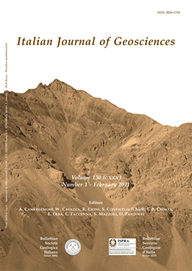
Dinosaur tracks in a marginal marine environment: the Coste dell'Anglone ichnosite (Early Jurassic, Trento Platform, NE Italy)
Fabio Massimo Petti(*), (**), Massimo Bernardi(*), Paolo Ferretti(*), Riccardo Tomasoni(*) & Marco Avanzini(*)
(*) Museo Tridentino di Scienze Naturali, Via Calepina, 14 -38122 Trento, Italy. Corresponding Author: Fabio Massimo Petti;Telephone: +39-3394980658; Fax: +39-0461 270376; E-mail address:fabio.petti@mtsn.tn.it
(**) Sapienza Università di Roma, Dipartimento di Scienze della Terra, Piazzale Aldo Moro, 5 - 00185 Rome, Italy.
DOI: https://doi.org/10.3301/IJG.2010.19
Volume: 130 (2011) f.1
Pages: 27-41
Abstract
Bipedal tridactyl dinosaur footprints dominate the Early Jurassic Coste dell'Anglone tracksite, located on the eastern slope of the Mt. Biaina-Mt. Brento chain (Trentino Alto-Adige, NE Italy). The site yielded 544 tridactyl footprints, arranged in 20 long trackways, and belongs to the upper part of the Calcari Grigi Group (lower portion of the Rotzo formation). All the tracks can be attributed to smalland medium-sized theropods. Trace fossils were discovered in a peri tidal carbonate succession deposited in a marginal area of the Trento carbonate Platform, which has so far been considered fully marine (subtidal) in origin. The Coste dell'Anglone outcrop represents one of the most extensive Early Jurassic dinosaur tracksites in the Southern Alps and is probably the last dinosaur occurrence on the Trento Platform. The ichnological and sedimentological analyses of the track-bearing sequence indicate a depositional setting corresponding to a tidal flat embayment, positioned on the westernmost sector of the Trento Platform, close to the Lombardy pelagic basin.
Stratigraphical data indicate that dinosaur populations lived in this area until the Sinemurian.
A comparison with the Early Jurassic theropod tracks global record is here provided, along with an investigation into the possible trackmaker. The tracks share unambiguous similarities with the tridactyl tracks discovered at the Lavini di Marco tracksite, in the basal portion of the Calcari Grigi Group (Monte Zugna formation, Hettangian) and with theropod tracks from the Lower Jurassic of Poland, France and the United States. This new discovery therefore supports calls for a re-examination of the palaeogeographic reconstruction of the Southern Alps during the Early Jurassic.
Keywords
Get Full Text